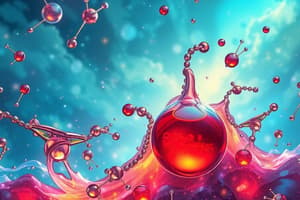Podcast
Questions and Answers
What is the component in a solution that determines the phase of the solution?
What is the component in a solution that determines the phase of the solution?
- Non-electrolyte
- Electrolyte
- Solute
- Solvent (correct)
Which class of solutes includes substances that do not yield ions when dissolved in water?
Which class of solutes includes substances that do not yield ions when dissolved in water?
- Electrolytes
- Weak electrolytes
- Non-electrolytes (correct)
- Strong electrolytes
What is the classification of a substance like HCl that forms ions when dissolved in water?
What is the classification of a substance like HCl that forms ions when dissolved in water?
- Electrolyte (correct)
- Weak electrolyte
- Non-electrolyte
- Crystalline solid
How many types of homogeneous mixtures of solute and solvent are possible according to the text?
How many types of homogeneous mixtures of solute and solvent are possible according to the text?
In which state of matter can the thermal motions of molecules overcome attractive forces between them?
In which state of matter can the thermal motions of molecules overcome attractive forces between them?
What type of substances are naphthalene and urea classified as in terms of electrolytic properties?
What type of substances are naphthalene and urea classified as in terms of electrolytic properties?
What is the main difference between intramolecular forces and intermolecular forces?
What is the main difference between intramolecular forces and intermolecular forces?
Which of the following best describes the Van der Waals forces?
Which of the following best describes the Van der Waals forces?
What type of force occurs between polar and nonpolar molecules?
What type of force occurs between polar and nonpolar molecules?
Cohesion is best described as:
Cohesion is best described as:
What is the main difference between hydrogen bonding and Van der Waals forces?
What is the main difference between hydrogen bonding and Van der Waals forces?
Which type of force arises between nonpolar molecules that can induce polarity in each other?
Which type of force arises between nonpolar molecules that can induce polarity in each other?




